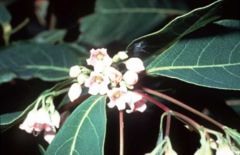Apocynum cannabinum: Difference between revisions
No edit summary |
No edit summary |
||
| Line 1: | Line 1: | ||
{{SPlantbox | |||
|genus=Apocynum | |||
|species=cannabinum | |||
|Temp Metric=°F | |||
|jumpin=If this plant info box on watering; zones; height; etc. is mostly empty you can click on the edit tab and fill in the blanks! | |||
|image=Upload.png | |||
|image_width=240 | |||
}} | |||
{{Inc| | |||
Apocynum cannabinum, Linn. Branches erect or nearly so: lobes of corolla nearly erect, the tube not longer than calyx: Lvs. ovate to lance-oblong, short-petioled: cymes dense; fls. greenish white. Northern states; common.— Not known to be in the trade, but likely to be confounded with the above. Root emetic, cathartic, diaphoretic, expectorant, and diuretic. The tough fibrous bark of the stalks formerly used by the Indians for making twine. | |||
}} | |||
{{Taxobox | {{Taxobox | ||
| color = lightgreen | | color = lightgreen | ||
| Line 16: | Line 28: | ||
}} | }} | ||
'''''Apocynum cannabinum''''' ('''Dogbane''', '''Amy Root''', or '''Indian hemp''') is a [[perennial plant|perennial]] [[herbaceous]] plant that grows throughout much of [[North America]], in the southern half of [[Canada]] and throughout the [[United States]]. It grows up to 2 meters tall. It prefers moist places. It is a [[poison]]ous plant; the name means | '''''Apocynum cannabinum''''' ('''Dogbane''', '''Amy Root''', or '''Indian hemp''') is a [[perennial plant|perennial]] [[herbaceous]] plant that grows throughout much of [[North America]], in the southern half of [[Canada]] and throughout the [[United States]]. It grows up to 2 meters tall. It prefers moist places. It is a [[poison]]ous plant; the name means "poisonous to dogs". All parts of the plant are poisonous and can cause cardiac arrest if ingested. | ||
The stems are reddish and contain a milky [[latex]] capable of causing skin blisters. The [[leaf|leaves]] are opposite, simple broad lanceolate, 7-15 cm long and 3-5 cm broad, entire, and smooth on top with white hairs on the underside. The [[flower]]s are produced in mid summer, with large sepals, and a five-lobed white corolla. | The stems are reddish and contain a milky [[latex]] capable of causing skin blisters. The [[leaf|leaves]] are opposite, simple broad lanceolate, 7-15 cm long and 3-5 cm broad, entire, and smooth on top with white hairs on the underside. The [[flower]]s are produced in mid summer, with large sepals, and a five-lobed white corolla. | ||
Revision as of 09:53, 19 January 2010
| Apocynum cannabinum subsp. var. | ||||||||||||||||||||||||||||||||||||||||||||||||||||||||
|---|---|---|---|---|---|---|---|---|---|---|---|---|---|---|---|---|---|---|---|---|---|---|---|---|---|---|---|---|---|---|---|---|---|---|---|---|---|---|---|---|---|---|---|---|---|---|---|---|---|---|---|---|---|---|---|---|

|
|
| ||||||||||||||||||||||||||||||||||||||||||||||||||||||
| ||||||||||||||||||||||||||||||||||||||||||||||||||||||||
| Standard Cyclopedia of Horticulture |
|---|
|
Apocynum cannabinum, Linn. Branches erect or nearly so: lobes of corolla nearly erect, the tube not longer than calyx: Lvs. ovate to lance-oblong, short-petioled: cymes dense; fls. greenish white. Northern states; common.— Not known to be in the trade, but likely to be confounded with the above. Root emetic, cathartic, diaphoretic, expectorant, and diuretic. The tough fibrous bark of the stalks formerly used by the Indians for making twine.
|
| Apocynum cannabinum {{{status}}} Fossil range: {{{fossil_range}}}
| ||||||||||||||||||||||||||||||||||||||||||||||||||||||||||||||||||
|---|---|---|---|---|---|---|---|---|---|---|---|---|---|---|---|---|---|---|---|---|---|---|---|---|---|---|---|---|---|---|---|---|---|---|---|---|---|---|---|---|---|---|---|---|---|---|---|---|---|---|---|---|---|---|---|---|---|---|---|---|---|---|---|---|---|---|
 Apocynum cannabinum in flower | ||||||||||||||||||||||||||||||||||||||||||||||||||||||||||||||||||
| Plant Info | ||||||||||||||||||||||||||||||||||||||||||||||||||||||||||||||||||
| ||||||||||||||||||||||||||||||||||||||||||||||||||||||||||||||||||
| Scientific classification | ||||||||||||||||||||||||||||||||||||||||||||||||||||||||||||||||||
| ||||||||||||||||||||||||||||||||||||||||||||||||||||||||||||||||||
| [[{{{diversity_link}}}|Diversity]] | ||||||||||||||||||||||||||||||||||||||||||||||||||||||||||||||||||
| {{{diversity}}} | ||||||||||||||||||||||||||||||||||||||||||||||||||||||||||||||||||
| Binomial name | ||||||||||||||||||||||||||||||||||||||||||||||||||||||||||||||||||
| Apocynum cannabinum L. | ||||||||||||||||||||||||||||||||||||||||||||||||||||||||||||||||||
| Trinomial name | ||||||||||||||||||||||||||||||||||||||||||||||||||||||||||||||||||
| {{{trinomial}}} | ||||||||||||||||||||||||||||||||||||||||||||||||||||||||||||||||||
| Type Species | ||||||||||||||||||||||||||||||||||||||||||||||||||||||||||||||||||
| {{{type_species}}} | ||||||||||||||||||||||||||||||||||||||||||||||||||||||||||||||||||
| {{{subdivision_ranks}}} | ||||||||||||||||||||||||||||||||||||||||||||||||||||||||||||||||||
| [[Image:{{{range_map}}}|{{{range_map_width}}}|]] | ||||||||||||||||||||||||||||||||||||||||||||||||||||||||||||||||||
| Synonyms | ||||||||||||||||||||||||||||||||||||||||||||||||||||||||||||||||||
| {{{synonyms}}} |
Apocynum cannabinum (Dogbane, Amy Root, or Indian hemp) is a perennial herbaceous plant that grows throughout much of North America, in the southern half of Canada and throughout the United States. It grows up to 2 meters tall. It prefers moist places. It is a poisonous plant; the name means "poisonous to dogs". All parts of the plant are poisonous and can cause cardiac arrest if ingested.
The stems are reddish and contain a milky latex capable of causing skin blisters. The leaves are opposite, simple broad lanceolate, 7-15 cm long and 3-5 cm broad, entire, and smooth on top with white hairs on the underside. The flowers are produced in mid summer, with large sepals, and a five-lobed white corolla.
It grows in open wooded areas, ditches, and hillsides; in gardens it can be invasive, growing from spreading roots.
Uses
Indian hemp was used as a source of fiber by Native Americans, to make hunting nets, fishing lines, clothing, and twine. It was also used in herbal medicine to treat syphilis, rheumatism, intestinal worms, fever, asthma, and dysentery. Although the toxins from the plant can cause nausea and catharsis, it has also been used for slowing the pulse.